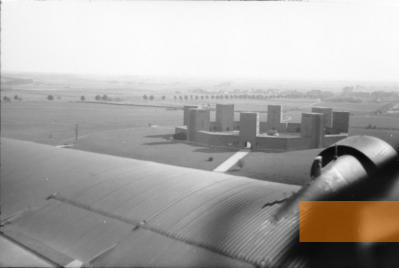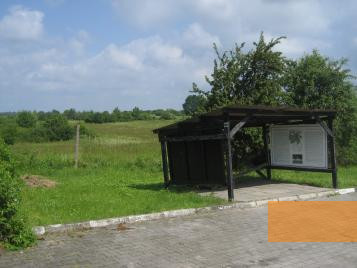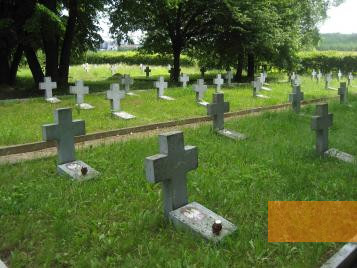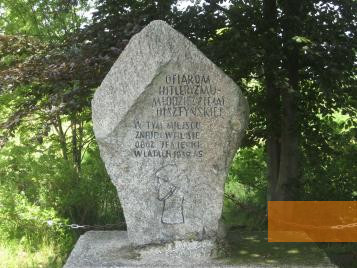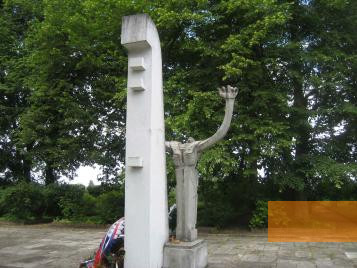A memorial stone and cemetery close to Olsztynek (German: Hohenstein) commemorate the East Prussian prisoner of war camp Stalag I b, which existed between 1939 and 1944/45, and honour its approximately 55,000 victims. Since 2015, a museum about the camp was opened in the town's centre.
The East Prussian town of Hohenstein (now: Olsztynek) is located in the midst of the battlefields of World War I: here, troops of the Russian tsar suffered a crushing defeat to the German troops led by Paul von Hindenburg in August 1914. The victory of Tannenberg was commemorated with a national memorial close to Hohenstein, which was dedicated in 1927 and turned into a »Reich honorary memorial« in 1934 following Hindenburg's death and burial on the site. In the summer of 1939, preparations were made for celebrations of the 25th anniversary of the battle. The ceremony never took place; the tent and barrack town for the approximately 10,000 veterans became an internment camp for prisoners of war.
The first POW camps were set up in East Prussia at the beginning of the war in September 1939 due to the region's vicinity to the Polish and Soviet borders; many more followed in the summer of 1941, following the German invasion of the Soviet Union. The largest of these camps – most probably the largest POW camp on German territory – was the Stalag I b in Königsgut (now: Królikowo) near Hohenstein. The prisoners had a view of the eight towers of the Tannenberg memorial, the region's most important tourist attraction. The prisoners were held behind barbed wire in 50 barracks: from 1939, Polish POWs, beginning 1940, POWs from France and Belgium – also from North Africa – from 1941 on, Soviet POWs and finally, from 1943, Italians. All of the prisoners had to carry out forced labour.
There is little Polish research on the history of the POW camp; much remains uncertain. It is possible that about 650,000 soldiers passed through Stalag I b in the course of the war. The camp was dismantled at the latest in January 19445 during the Soviet invasion of East Prussia; the flight of the civilian population began and German pioneers blew up parts of the Tannenberg memorial. In the summer of 1945, southern East Prussia became part of Poland by decision of the victorious powers.
The first POW camps were set up in East Prussia at the beginning of the war in September 1939 due to the region's vicinity to the Polish and Soviet borders; many more followed in the summer of 1941, following the German invasion of the Soviet Union. The largest of these camps – most probably the largest POW camp on German territory – was the Stalag I b in Königsgut (now: Królikowo) near Hohenstein. The prisoners had a view of the eight towers of the Tannenberg memorial, the region's most important tourist attraction. The prisoners were held behind barbed wire in 50 barracks: from 1939, Polish POWs, beginning 1940, POWs from France and Belgium – also from North Africa – from 1941 on, Soviet POWs and finally, from 1943, Italians. All of the prisoners had to carry out forced labour.
There is little Polish research on the history of the POW camp; much remains uncertain. It is possible that about 650,000 soldiers passed through Stalag I b in the course of the war. The camp was dismantled at the latest in January 19445 during the Soviet invasion of East Prussia; the flight of the civilian population began and German pioneers blew up parts of the Tannenberg memorial. In the summer of 1945, southern East Prussia became part of Poland by decision of the victorious powers.
An estimated 55,000 prisoners of war perished at Stalag I b close to East Prussian Hohenstein between 1939 and 1944/45 - including about 50,000 Red Army soldiers, but also Polish, French, Belgian and Italian soldiers.
After the end of the war, the remains of the French and Belgian victims were transported back to their home countries; the bodies of the Italian soldiers were exhumed and buried on the Italian cemetery in Warsaw. The Soviet and Polish victims were laid to rest in Sudwa (German: Sauden), just outside of Hohenstein - now Olsztynek. At the centre of the war grave complex is a sculpture by Polish artist Ryszard Wachowski (1930–1985). The former camp premises in Królikowo are signposted. A sign bears information in Polish, English, German and Russian, and there is a memorial stone dedicated to »the victims of Nazism - the youth of the Olsztyn province. Located here was a German prisoner of war camp 1939–1945«. No traces of the camp remain on the historic site.
Since 2015, there is a museum with multimedia elements in the town's centre dedicated to the history of the camp and the everyday life of its inmates.
Since 2015, there is a museum with multimedia elements in the town's centre dedicated to the history of the camp and the everyday life of its inmates.
- Name
- Były obóz jeńców wojennych Stalag I b Hohenstein
- Phone
- +48 (0)89 519 54 90
- Web
- https://olsztynek.pl/multimedialne-muzeum-stalagu-ib-i-historii-olsztynka/koncepcja-powstania-muzeum/
- muzeum@olsztynek.pl
- Open
- The premises are accessible at all times.
The museum is open Monday to Friday 8 a.m. to 4 p.m.
Saturday and Sunday 10 a.m. to 2 p.m.


